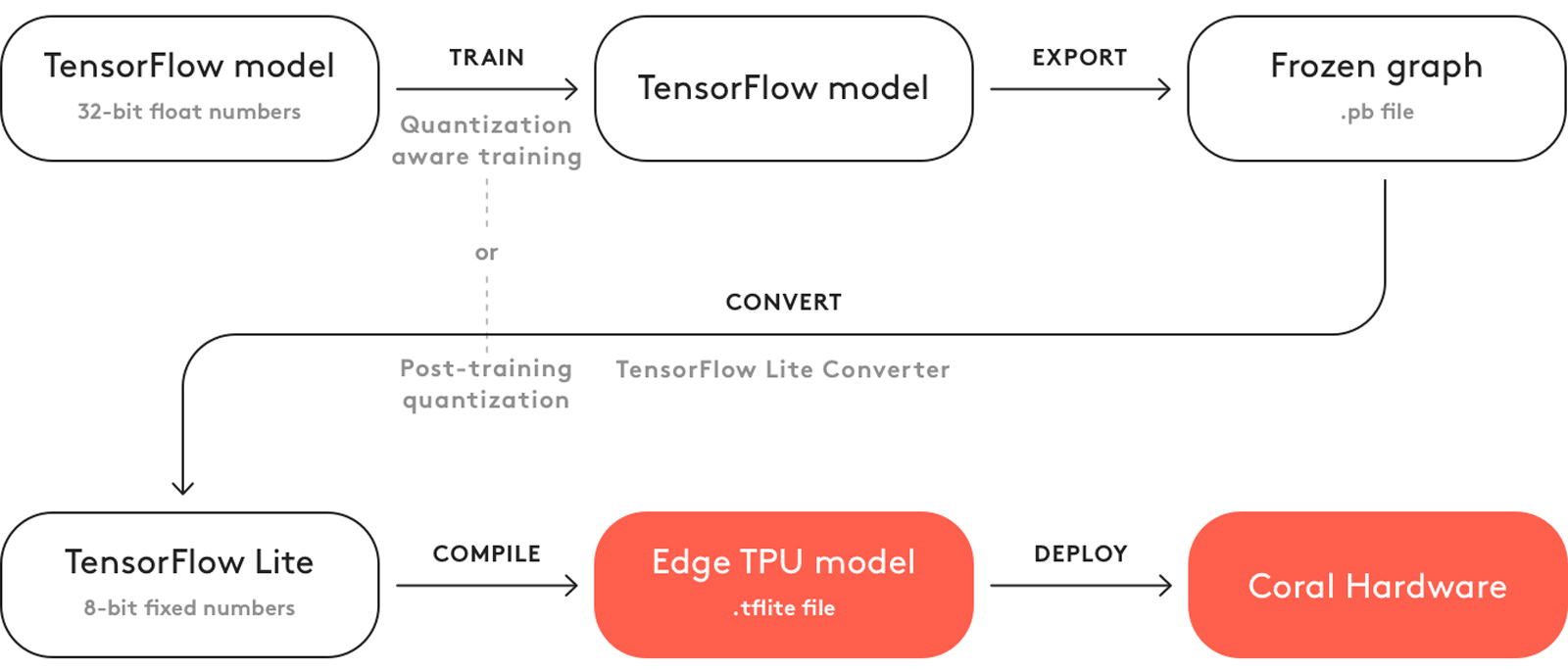7.6 KiB
| comments | description | keywords |
|---|---|---|
| true | Discover how to uplift your Ultralytics YOLOv8 model's overall performance with the TFLite Edge TPU export format, which is perfect for mobile and embedded devices. | Ultralytics, YOLOv8, TFLite edge TPU format, Export YOLOv8, Model Deployment, Flexible Deployment |
Learn to Export to TFLite Edge TPU Format From YOLOv8 Model
Deploying computer vision models on devices with limited computational power, such as mobile or embedded systems, can be tricky. Using a model format that is optimized for faster performance simplifies the process. The TensorFlow Lite Edge TPU or TFLite Edge TPU model format is designed to use minimal power while delivering fast performance for neural networks.
The export to TFLite Edge TPU format feature allows you to optimize your Ultralytics YOLOv8 models for high-speed and low-power inferencing. In this guide, we'll walk you through converting your models to the TFLite Edge TPU format, making it easier for your models to perform well on various mobile and embedded devices.
Why Should You Export to TFLite Edge TPU?
Exporting models to TensorFlow Edge TPU makes machine learning tasks fast and efficient. This technology suits applications with limited power, computing resources, and connectivity. The Edge TPU is a hardware accelerator by Google. It speeds up TensorFlow Lite models on edge devices. The image below shows an example of the process involved.

The Edge TPU works with quantized models. Quantization makes models smaller and faster without losing much accuracy. It is ideal for the limited resources of edge computing, allowing applications to respond quickly by reducing latency and allowing for quick data processing locally, without cloud dependency. Local processing also keeps user data private and secure since it's not sent to a remote server.
Key Features of TFLite Edge TPU
Here are the key features that make TFLite Edge TPU a great model format choice for developers:
-
Optimized Performance on Edge Devices: The TFLite Edge TPU achieves high-speed neural networking performance through quantization, model optimization, hardware acceleration, and compiler optimization. Its minimalistic architecture contributes to its smaller size and cost-efficiency.
-
High Computational Throughput: TFLite Edge TPU combines specialized hardware acceleration and efficient runtime execution to achieve high computational throughput. It is well-suited for deploying machine learning models with stringent performance requirements on edge devices.
-
Efficient Matrix Computations: The TensorFlow Edge TPU is optimized for matrix operations, which are crucial for neural network computations. This efficiency is key in machine learning models, particularly those requiring numerous and complex matrix multiplications and transformations.
Deployment Options with TFLite Edge TPU
Before we jump into how to export YOLOv8 models to the TFLite Edge TPU format, let’s understand where TFLite Edge TPU models are usually used.
TFLite Edge TPU offers various deployment options for machine learning models, including:
-
On-Device Deployment: TensorFlow Edge TPU models can be directly deployed on mobile and embedded devices. On-device deployment allows the models to execute directly on the hardware, eliminating the need for cloud connectivity.
-
Edge Computing with Cloud TensorFlow TPUs: In scenarios where edge devices have limited processing capabilities, TensorFlow Edge TPUs can offload inference tasks to cloud servers equipped with TPUs.
-
Hybrid Deployment: A hybrid approach combines on-device and cloud deployment and offers a versatile and scalable solution for deploying machine learning models. Advantages include on-device processing for quick responses and cloud computing for more complex computations.
Exporting YOLOv8 Models to TFLite Edge TPU
You can expand model compatibility and deployment flexibility by converting YOLOv8 models to TensorFlow Edge TPU.
Installation
To install the required package, run:
!!! Tip "Installation"
=== "CLI"
```bash
# Install the required package for YOLOv8
pip install ultralytics
```
For detailed instructions and best practices related to the installation process, check our Ultralytics Installation guide. While installing the required packages for YOLOv8, if you encounter any difficulties, consult our Common Issues guide for solutions and tips.
Usage
Before diving into the usage instructions, it's important to note that while all Ultralytics YOLOv8 models are available for exporting, you can ensure that the model you select supports export functionality here.
!!! Example "Usage"
=== "Python"
```python
from ultralytics import YOLO
# Load the YOLOv8 model
model = YOLO('yolov8n.pt')
# Export the model to TFLite Edge TPU format
model.export(format='edgetpu') # creates 'yolov8n_full_integer_quant_edgetpu.tflite’
# Load the exported TFLite Edge TPU model
edgetpu_model = YOLO('yolov8n_full_integer_quant_edgetpu.tflite')
# Run inference
results = edgetpu_model('https://ultralytics.com/images/bus.jpg')
```
=== "CLI"
```bash
# Export a YOLOv8n PyTorch model to TFLite Edge TPU format
yolo export model=yolov8n.pt format=edgetpu # creates 'yolov8n_full_integer_quant_edgetpu.tflite'
# Run inference with the exported model
yolo predict model=yolov8n_full_integer_quant_edgetpu.tflite source='https://ultralytics.com/images/bus.jpg'
```
For more details about supported export options, visit the Ultralytics documentation page on deployment options.
Deploying Exported YOLOv8 TFLite Edge TPU Models
After successfully exporting your Ultralytics YOLOv8 models to TFLite Edge TPU format, you can now deploy them. The primary and recommended first step for running a TFLite Edge TPU model is to use the YOLO("model_edgetpu.tflite") method, as outlined in the previous usage code snippet.
However, for in-depth instructions on deploying your TFLite Edge TPU models, take a look at the following resources:
-
Coral Edge TPU on a Raspberry Pi with Ultralytics YOLOv8: Discover how to integrate Coral Edge TPUs with Raspberry Pi for enhanced machine learning capabilities.
-
Code Examples: Access practical TensorFlow Edge TPU deployment examples to kickstart your projects.
-
Run Inference on the Edge TPU with Python: Explore how to use the TensorFlow Lite Python API for Edge TPU applications, including setup and usage guidelines.
Summary
In this guide, we’ve learned how to export Ultralytics YOLOv8 models to TFLite Edge TPU format. By following the steps mentioned above, you can increase the speed and power of your computer vision applications.
For further details on usage, visit the Edge TPU official website.
Also, for more information on other Ultralytics YOLOv8 integrations, please visit our integration guide page. There, you'll discover valuable resources and insights.